By Bill Adams
At the eastern base of the Catskill Mountains, about an hour south of Albany, the state capital, and less than two hours north of New York City, is the small rural hamlet of Palenville, New York.
Located in the Town of Catskill, Palenville has about 1,000 inhabitants. The hamlet’s largest employer is Garrison Fire & Rescue Corporation, owned by Blake Garrison.
UNCLE CHET
Chet Garrison is Blake’s uncle. Formerly a fire safety representative for the State of New York, Chet worked part time for Tom Higgins Fire Equipment in Massapequa, Long Island, selling Maxim Fire Apparatus. In 1975, he started Garrison Fire & Safety Corporation as a sole proprietor working part time selling apparatus and ancillary equipment. He rented a building, and his wife Pat started working with him part time.
As the business grew, they both began working full time in 1990. Anticipating future growth in sales and service requirements and hiring additional full-time employees, Chet formed Garrison Fire & Rescue Corporation to oversee sales, service, and general day-to-day business. The original Garrison Fire & Safety Corporation had constructed and retained ownership of a new building at 3334 Route 23A in Palenville.
Asked why he ended up selling the business, Chet says, “It was time after 40 years. My wife and I wanted to retire to spend more time with family and grandchildren and to do some traveling. During my time in business, we saw many well-known brand names of both large and small fire truck manufacturers struggle. It was the beginning of mergers, sell-outs, and closings and included names like Maxim, Ward LaFrance, Sanford, American LaFrance, Mack, Hahn, Grumman, Saulsbury, and Beck—just to name a few.”
ENTER BLAKE
After graduating from Castleton University in 1990, Blake Garrison was hired by Garrison’s equipment division. Within 10 years, he moved into the apparatus sales division. Ten years later, Blake purchased the business. In 2021, he purchased the land and building. Recognized as an S-Corporation, Garrison Fire & Rescue Corporation is today 100% owned by Blake Garrison.
PALENVILLE FIRE DEPARTMENT
The Garrison family has been involved in the Palenville (NY) Fire Department for quite a while. Chet joined in 1965 and today serves as a fire commissioner in the Palenville Fire District. Blake says, “I grew up in a fire family. My father was a past chief and a county fire coordinator. Uncle Chet lived next door when he started running his business out of his home.
“Two years after starting to work for the Garrison team, I joined the fire department and eventually served 17 years as chief and assistant chief. Currently, I’m the president of the department. The majority of Garrison employees have decades of fire service experience, many of them serving as officers currently or in the past. The few nonfirefighting employees have direct ties to fire or law enforcement.”
THE MARKETPLACE
Garrison covers 26 counties in Eastern New York for Rosenbauer America. It also represents SVI Trucks. According to Blake, it does not sell ambulances and has no plans to do so, nor does it sell used apparatus. He describes the customer base as, “95% volunteer and 5% career or combination departments. It’s a diverse market including a handful of paid smaller city departments, suburban volunteers, and the majority of small volunteer departments.”
Garrison sells an average of 15 to 20 rigs a year—50% pumpers, 30% tankers, and 10% each aerial devices and rescues. It doesn’t sell many grass fire or brush trucks. When asked if Garrison has a niche in the market, Blake says, “We historically have been focused on the custom market, but commercial tankers have become a significant part of our sales. Rosenbauer’s diverse aerial offering has also allowed us to fit most needs our customers have.” The majority of the apparatus sold have formed aluminum bodies; however, extruded aluminum is also offered.

1 The Earlton (NY) Fire Department’s black-over-red pumper-tanker is a 1500/1500 on a flat-roof custom chassis with a 9 foot 1 inch overall height. Its 12-inch extended bumper has fully recessed air horns, mechanical and electronic sirens, and 6-inch front suction through the bumper face—common in Garrison’s territory. (Photos courtesy of Blake Garrison.)

2 The Athens (NY) Fire Department’s white-over-red custom chassis 1,500/2,000 pumper-tanker’s 20-inch extended painted bumper sports similar features plus a front discharge. It also has three speedlays.

3 The Schroon Lake (NY) Fire District’s all red custom 1,500/2,000 pumper-tanker has a 212-inch wheelbase and is 31 feet 7 inches long. Its extended bumper is only 6 inches long.
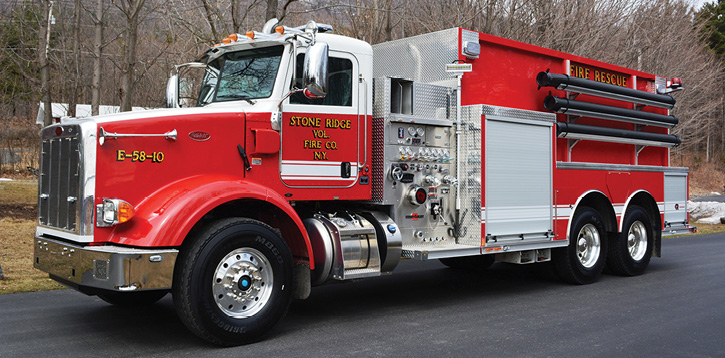
4 A big two-door Peterbilt commercial 1,250/3,000 unit was delivered to the Stone Ridge(NY) Fire District. You don’t often see individual 6-inch cab spotlights.
LOOSE EQUIPMENT
Garrison has a separate sales staff to handle ancillary equipment sales not included with a new apparatus purchase. It doesn’t do extinguisher testing and refilling or fixed extinguishing systems. Although hydrotesting is not provided in-house, Garrison is a factory-certified service representative for MSA. Blake states that besides MSA, it represents TFT, Globe, Snap-Tite, Holmatro, Hale, Super Vac, Bauer, Whelen, and Performance Advantage Company.
FACILITY AND SERVICE
Garrison’s facility encompasses 6,000 square feet with three service bays. There are five on-the-road service trucks. Two are for apparatus service, one is for Holmatro products, and two are for air products. Apparatus techs are EVT-certified. Technicians for Holmatro and MSA products are also certified.
There are approximately two dozen employees. Most are full-time employees. Blake says, “Most of our employees have been here over 10 years; some over 20 years. Our successes are the result of a team effort across the company.”
INTERVIEW WITH BLAKE GARRISON
Blake agreed to be interviewed on how Garrison Fire & Rescue views fire apparatus trends in its marketing area. He was given generalized topics (in italics) and free reign in responding. The following comments are his alone.
Cooperative apparatus purchasing: I believe most career departments have embraced co-op purchasing across the board. In the last couple years, we have had one bid total, and the rest bought through co-ops or were negotiated sales for the nonmunicipal accounts. Volunteers use co-op purchasing 90 to 95% of the time. Co-op purchasing has been a win/win in my mind for both the vendors and for the fire departments.
In the past, committees would invite up to a half dozen vendors when, in reality, there were maybe only a couple they were considering. Usually, they had a single vendor of choice. They would do the dance and check the box that they met with multiple vendors. Then, usually a proprietary spec was published that favored their vendor of choice. Ninety-five percent (guesstimate) of those customers ended up buying from the vendor of choice, and the other vendors went home as losers.
In today’s world of cooperative purchasing, truck committees can save several nights of going through the motions and only meet with a couple of desired vendors. Pricing is regulated to avoid gouging, and the vendor doesn’t need to spend a night in a firehouse that truly has no interest in its truck. It doesn’t hurt my feelings if you say, “I like Brand A, and I’m going to buy another one.” I wouldn’t ask Chevy to build me a Dodge pickup truck. Vendors have their own way of building, so find the one you trust that has a product in your budget and buy it. Most past attempts at writing open specifications result in a truck that no vendor can build and a lot of confusion as to what the customer will actually get as a finished product.

5 A four-wheel-drive custom 1,500/750 with 30 gallons of foam went to the Millerton (NY) Fire Company (North East Fire District). It has dual 200-foot 1¾-inch crosslays recessed into the 24-inch extended front bumper along with a bumper-mounted monitor.
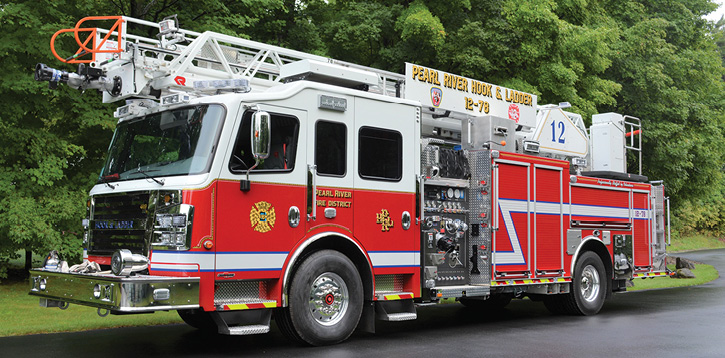
6 The Pearl River (NY) Fire District took delivery of a custom chassis single-rear-axle 2,000/500 with a 78-foot rear-mount aerial.
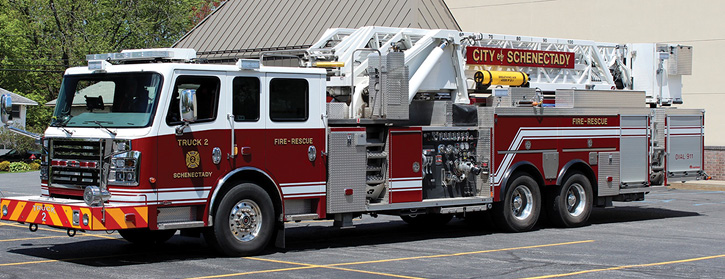
7 A 2,000/300 100-foot midmount tower ladder went to the Schenectady (NY) Fire Department.
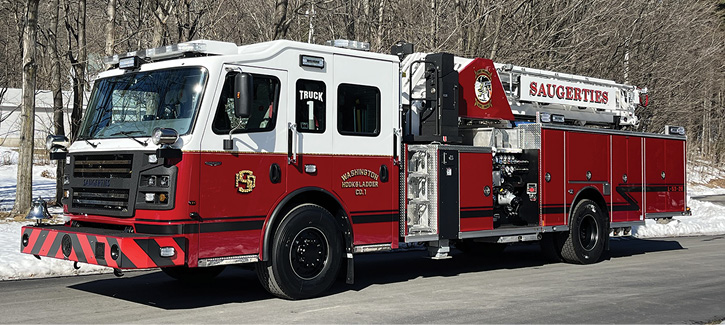
8 The Saugerties (NY) Fire Department runs a 1,500/300 with midmount 75-foot aerial.
Customers today are pretty savvy and have done their research through talking with neighbors and a lot of Web site and social media surfing. Maybe they aren’t scrutinizing RBM measurements on metals or torque specs on fasteners, but they know what vendors are doing things right. Most vendors out there are building good trucks. Yes, you can quote me on that. Your vendor, if he or she does their job, will tell you why they think that their truck is better. Vendors still need to sell themselves, their dealership, and their truck. Co-op purchasing doesn’t negate the need to look at what’s available on the market and what their dealer brings to the table. It eliminates the final step (bidding) that became a formality over the years.
Purchasing specifications: We saw mostly proprietary rather than performance or open specs when fire departments were still doing a lot of bidding. I would prefer proprietary specs from another vendor over performance or generic. At least those trucks could be built, and there were no gray areas. Four-page specs and performance specs are nightmares for vendors. Either there is too much info or not enough. We see very few published specs; however, there have been a few that had outside consultant assistance. Most specs in the past that end up being published are vendor-driven.
Specification compliance or low bid: Again, very few published bids are crossing our desks, but we would hope that there is attention to spec compliance. If the plan is to buy low bid, why would a truck committee waste its time to look at numerous vendors, go to trade shows, and read literature when price is the ultimate driving factor? We don’t have an abundance of independent volunteer departments, but the ones we have will typically just negotiate a purchase, similar to what is done on a co-op purchase but without their oversight.
Multipurpose apparatus: There is a trend toward purchasing multipurpose apparatus, obviously because of staffing. Very few firehouses we visit complain about too many firefighters showing up to calls. The [number of] people volunteering has dropped dramatically, and employers are less likely to allow employees to leave work several times a week for fire calls. The career departments are working with smaller crews due to reduced staffing as well. Departments are rolling out with one piece more often than not and need water, tools, lights, and people. The call load has also increased with more nonfire-type calls that require a rolling toolbox while keeping the firefighting capabilities. Our Adirondack Tanker meets those needs.
Purchase OEMs’ standard offerings or reinvent the wheel: The majority of units we sell have a fair amount of customization, but the wheel can only be reinvented so many times. With social media and libraries of digital photos, we can usually copy something that’s already been done successfully. We have a fairly “seasoned” staff that has been around a while and has seen a lot. Challenges keep our jobs exciting, and we think our input brings some good ideas to the table for the customer.
Stock and demo apparatus: Most customers ask about demo trucks in today’s market due to the extended delivery times of new builds. The benefits of getting something quick and perhaps at last year’s price are always enticing. We find that most departments still want something very specific in their apparatus. “I like this demo but I want more water,” or, “it needs to be low-profile to fit our station.” It’s never exactly what they want, so they opt to wait and order “their” truck. They are purchasing these units with 20- to 25-year life expectancies, so waiting the additional time outweighs settling for something that is built. The demo pool is pretty shallow currently, but we do find the right fit on occasion and match a customer with a demo.
NFPA 1900, Standard for Aircraft Rescue and Firefighting Vehicles, Automotive Fire Apparatus, Wildland Fire Apparatus, and Automotive Ambulances: Having four separate standards previously made it easier to look something up, but consolidation avoided a fair amount of duplication. Most customers rely on us and the builder to ensure National Fire Protection Association (NFPA) compliance. I can’t remember the last time I was at a truck committee meeting or final inspection where the “Red Book” 1901 standard was whipped out by a customer. We only sell NFPA-compliant apparatus.
Wildland urban interface (WUI) apparatus: We haven’t seen many of the WUI vehicles in our area. Rosenbauer makes the Timberwolf that sells well in different parts of the country, but we have only sold a handful. Mini pumpers have had a recent comeback for departments replacing 20-plus-year-old units, some of which are from the Saulsbury days.
Clean cabs: The clean cab concept had its “flash in the pan” moment a year or two ago. People asked about it, and manufacturers responded with removable seat covers, removing self-contained breathing apparatus (SCBA) from the cab, and other measures. The cab filtration units are gaining some momentum and have been well received, but the SCBA are back in the cab again for the most part.
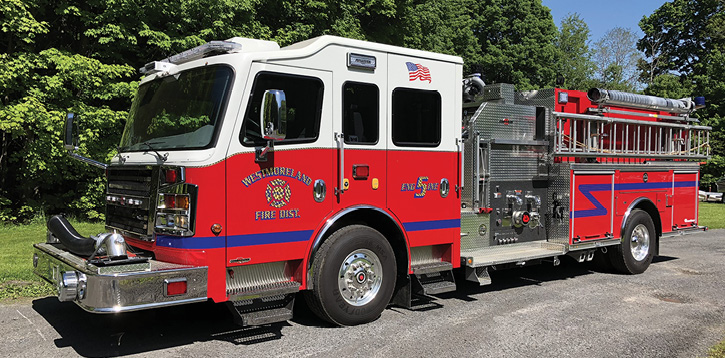
9 The Westmorerland (NY) Fire District took delivery of a 1,500/1,500 custom with a top-mount operator’s panel and a front preconnected soft sleeve for drafting.

10 The Summit (NY) Fire District runs an all red four-door commercial chassis 1,250/1,000 pumper.
Electric fire apparatus: The Northeast is very traditional, so we have not had much interest in the electric vehicle technology. I think it is a matter of time before these vehicles make their way into the fleets in our area, but the diesel-driven fire trucks will be the preference for a while longer. The technology seems to be progressing and gaining glimmers of interest, but as long as there are still leather helmets on the purchasers’ heads, there will be resistance.
Vendors’ service capabilities: We see most specs have desired service requirements. Even the best apparatus break on occasion, so having a dependable service facility is critical for fire departments. We deal with a good percentage of volunteer departments, so offering the mobile service or pickup service has been beneficial, as they don’t have the manpower to sacrifice a day of work to bring a truck in. The career departments don’t have solid reserve fleets, so limiting the downtime of their out-of-service apparatus is imperative.
OEMs merging and consolidating: No comments at this time.
Apparatus refurbishing: We see very little, virtually no refurb activity. With advancements in technology, most are opting toward buying new.
COVID 19: We were deemed an “Essential Business” in New York State from the very first days of COVID, so we were able to come to work and get things done. We saw in-person meetings with customers and potential customers stop completely for a while. Zoom meetings were happening but couldn’t replace face-to-face effectiveness. Districts could not hold referendums to get approvals. We couldn’t size members for turnout gear, and final inspections switched to virtual. It was completely disruptive for a while, but we pivoted and made it work. For the most part, the fire equipment business has recovered from COVID. I think there will be lingering effects, but most business is back to normal.
Supply chain issues: Supply chain issues were a major disruption over the last few years that we still have not emerged from. Fire apparatus went from 365-day delivery to now in excess of two years in some cases for a variety of reasons. We see some improvements, but it will be a while before we see the apparatus industry return to prepandemic delivery times. Loose equipment such as turnout gear, fire hose, and rescue tools has also seen delivery times reach unprecedented time frames. Turnout gear particularly presents unique challenges. New members in volunteer departments or new hires in the career houses need turnout gear for class/academy. Delivery times had stretched beyond one year and presented obvious challenges. Our gear vendor is now down to four to five months, which isn’t ideal but a good improvement.
TYPICAL RIGS
Describe your basic pumper sale: It’ll have a 1,500-gallon-per-minute (gpm) pump and a 1,000-gallon tank. Eighty-five percent are on a Rosenbauer custom chassis with six seats, 15% are on two-seat commercial chassis, and most are set up for 5-inch large-diameter hose. About 85% have side-mount pump panels. The rest have top-mount panels with a few rear-mounted pumps sold each year.
Some have onboard foam systems, but lately there’s been a decline in them. Most all custom cabs have Rosenbauer’s standard 11-inch raised roof, which offers added head room while keeping travel height manageable for older firehouses. We noticed a trend within the past few years breaking the 85:15 custom-to-commercial-chassis ratio. In fact, 2022 saw the majority of our total sold units on commercial chassis. Most all rigs’ paint schemes are white over red with some recent black or gray over red trending lately.
Describe your basic ladder truck sale: There’s an even split between 78-foot rear-mount aerials and 100-foot midship-mounted platforms, although we did sell a 75-foot midship-mounted aerial. All are quints with the exception of a city rig now and then with no pump or tank. Tillers are very limited in our territory; we’ve sold none.
Describe your basic tanker sale: The average tank capacity is 2,000 gallons on single rear axles and 3,000 gallons on dual rear axles. Dry side tanks are more popular due to the added protection against limbs in our rural settings. Very few are wet side, and we’ve not sold any oval tanks. Pumper-tankers usually have 1,500-gpm pumps and only 500-gpm pumps on the “water movers.”
Tankers with full-size pumps have been popular, especially in the 1,800- to 2,000-gallon single-axle range. And, tankers are where we see most of our commercial chassis sales with very few custom cabs and chassis. Here at Garrison, our team developed a “standard” rig on paper that in-house we call the Adirondack Tanker. It’s on a single rear axle with the big water (1,800 to 2,000 gallons) and a 1,500-gpm pump on either a commercial or a Rosenbauer custom cab and chassis. They have become popular in our territory in the Adirondack Mountains (ergo the name) and have gained momentum throughout the remainder of our territory. It packs a big punch into a manageable size package that both rural and small staff-strapped departments have asked for. It meets NFPA 1900’s criteria for a full-size pumper and a tanker. Most are equipped with multiple preconnects, front suctions, rear dump valves with swivels, portable tank holders, and aluminum bodies. As with any “standardized” rig, customers always want options that within reason we can accommodate.
Describe your basic rescue truck sale: Most are the walk-around style on a custom cab and chassis with a 20-kW hydraulic PTO generator. Consolidating a pumper and rescue into a rescue-pumper is making a comeback.
WORDS OF WISDOM
Blake Garrison says, “Most vendors build good trucks, and most distributors are pretty reputable. Find a vendor that has a product line you are comfortable with, offers an acceptable level of service, and offers a price within your budget. Definitely shop around and talk to your neighbors. But, at the end of the day, buy the truck that best suits your needs from a dealer who can support you and that you trust. Prices continue to climb with inflation and NFPA-required standards. Know your budget.
“Longer delivery times will also require better planning by purchasers. If fire departments wait until a 25- to 30-year-old apparatus dies, they may be without a replacement for a couple of years. Move your purchasing process up a year or two.”
BILL ADAMS is a member of the Fire Apparatus & Emergency Equipment Editorial Advisory Board, a former fire apparatus salesman, and a past chief of the East Rochester (NY) Fire Department. He has 50 years of experience in the volunteer fire service.

